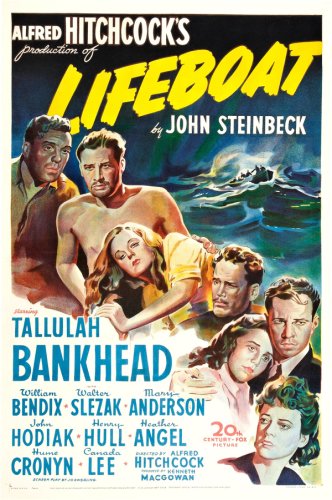

After the operation on Gus's leg, the group is playing cards.
The sound is the same audio from the card game earlier in the film.
Ritt stays.
Kovac takes three cards.
You can see when Kovac supposedly says, "Three cards," his lips don't move at all.
When Gus is chugging brandy, the amount in the bottle remains the same and does not go down.
When Talulah offers to use her diamond bracelet as a fishing lure, the fish that swallows it is a carp, a fresh water fish, which would be unlikely to strike at a flashy lure anyway since it is a toothless herbivore.
The fish that is seen underwater going after Connie's gem bait is obviously being pulled to it by a line attached to its mouth, and never opens its mouth to take the object when it makes its "strike".
After Connie helps the first man onto the lifeboat, she is holding the camera with her right hand and helping him with her left hand.
In the subsequent shoot, she is no longer holding the camera and her right is wet and dirty.
After Willy catches the baby, the position of his right arm changes in between shots.
A curl of Connie's hair switches from being loose and blowing in the breeze to tightly pinned back between shots during the scene when Connie asks Kovac to fix the clasp on her bracelet.
After Gus awakes from his amputation, the nurse has both arms near her at first.
Then, she is leaning over Gus with her right arm outstretched in the next shot.
In the beginning of the film, a German U-boat crew member is floating in the water.
He is wearing a life jacket with the words "Deutsches Reich U 78" printed on it.
If they decided to print words on the jacket, Kriegsmarine" would be more appropriate.
Also the U-78 was used as a trainer and never saw combat.
The U-boat captain they rescue doesn't seem to wear any kind of military uniform.
He is wearing, what looks like, civilian clothing.
A stuntman portraying Gus is briefly seen standing in the stern of the boat before a wave throws him overboard, although Gus just had his leg amputated moments before and he was lying down! You can see, that the stuntman actually jumps into the water before the wave hits.
The "amputated" leg can also be seen tied behind Gus's thigh when they get him back to the boat.
Alfred Hitchcock 1944 thriller where a group of survivors literally cling to a life-boat after their ship has been torpedoed by German submarines during World War 11.Quite a different and varied cast are on the boat.
Saw The Lifeboat (1944) early this morning, when I was tucked up in bed with flu. Very enjoyable.
Rarely seen Hitchcock thriller which is well worth rooting out. People often forget just how experimental The Master could be and here he prefigures future exercises like the long takes of "Rope" and "Under Capricorn", the single fixed point setting for "Rear Window" and the B & W shock-horror of "Psycho" with a psychological drama set entirely at sea in a lifeboat.
No need to recap the plot.As a commentary on WWII and Nazis, the film is dated as an allegory on democratic individualism, the movie's still relevant.
Hitchcock's Lifeboat, from John Steinbeck's book, is a humane propaganda film, and one of the great shipwreck films. The claustrophobia and tensions of surviving on a small boat, adrift on the ocean, in the middle of war, comes through, as do the resulting challenges to personality and behavior.
Like many of Alfred Hitchcock's films, Lifeboat latches deeply into the mind and leads us along a dark voyage through ample fear and suspicion. In this case, it also manages to be extremely poignant, which it fairly ought to be considering the many horrific events it depicts.
Lifeboat (1944) *** 1/2 (out of 4) Alfred Hitchcock lined up a terrific cast to tell the story of a group of survivors who find themselves together on a lifeboat without much hope for survival. The American and British people end up saving a German man who was on the sub that struck their boat and must decide if he's worth trusting or not.
When we find out that Gus, who loves to dance, has a wound in his leg, we know right then he is doomed. Sure enough, the leg becomes gangrenous.
Alfred Hitchcock had an experimental streak in him, and I think, outside of his mandated use of sound at the beginning of talkies, Lifeboat represents his first effort to turn an entire film into an experiment. Later films fit this sort of effort, like the one-shot technique of Rope, the use of 3D in Dial M for Murder, or the use of his television crew for Psycho, but it's Lifeboat that feels like Hitchcock using a film as an excuse just to try something.